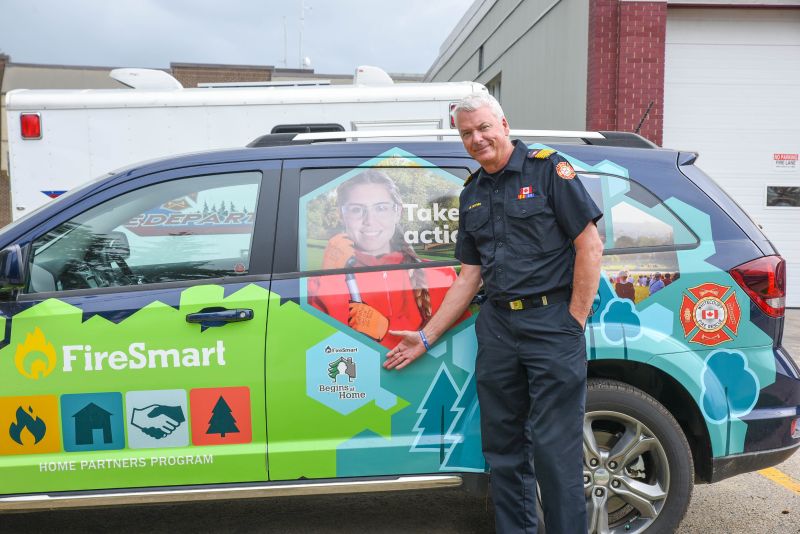FireSmarting Whitecourt; one year at a time

Since 2010, FireSmart practices have been part of the fabric of the community. The Whitecourt Fire Department is very active in providing education opportunities for its members and residents to raise awareness of the importance of being FireSmart both at the home level and municipality wide.
Each year since its inception, the Whitecourt Fire Department provides a report to Whitecourt Town Council on the FireSmart work they’ve done in the previous twelve months. During the final public council meeting of the year, Fire Chief Brian Wynn provided his department’s report for 2022. The report is also an integral step in grant application guidelines for the department.
One grant the department hopes to snag again this year is for their Summer Crew which is made up of young adults who do forest clean-up in greenspaces near neighbourhoods. “The Summer Crew is probably the hardest grant for us to get, so we are trying to really, really push it and to educate FRIAA (Forest Resource Improvement Association of Alberta) about what an active group that this is for four months and that they are selling FireSmart in our community,” explained Chief Wynn.
He said the grant is harder to get because FRIAA is opposed to summer crews. “In some areas, the summer crews were mowing soccer fields and not being used for actual FireSmart work. It kind of taints the flavour for summer crews. But we have a proven track record of seven years now. FRIAA and anybody who comes to Whitecourt knows what our crew does. It’s just about pushing that point, and with this report, and a lot more information that we are sending to FRIAA, including a daily log of everything that the Summer Crew does, hopefully, the justification is pretty black and white,” explained Chief Wynn.
The crew receives two weeks of comprehensive training before getting started, including, but not limited to, safety orientation, chainsaw certification, first aid and WHIMIS/TDG. “We had them at the Trade Fair and the Farmer’s Market. We also had them trained to do home assessments, so they were part of the crew that completed 32 home assessments,” said Chief Wynn. He added that when the crew was out working, they would chat with residents who came upon the area. “They chatted with many people daily.”
The FireSmart Homeowner Incentive Program allowed residents to sign up for a home assessment by the department, learn about things they could do to mitigate their wildfire risks and incentivize them to conduct recommended changes. “The home incentives really kicked off this year (2022). We hope to have more next year (2023). So far, for that incentive program, we’ve only received one application for funding.” Chief Wynn said they would push the home assessment opportunity hard to get more homeowners aware of it and signed up.
FireSmart is a tool that cost-effectively changes the natural environment to increase a home or community’s survivability when facing a wildfire. Certain shrubbery, dead trees, tall grass, debris, and low-laying branches are a big focus for crews. The forested areas are broken down into zones with heavier emphasis placed on those most at risk.
A big part of the project involves mowing. Previously overgrown areas, having been mulched down by crews, can now be upkept with mowing rather than needing the more extensive equipment. In the Hilltop area, the focus was placed along the boundary of the residential regions, amounting to acres of work. Chief Wynn said their goal through FireSmart is to mow the area twice a year, once in June and again in mid-August. Late-season mowing means the grass would have less opportunity to grow and be an issue in the spring when snow melts and fire risk increases.
Large areas in the valley were also focused on through 2022, including along Flats Road in the green space between the road and residences, across from Graham Acres, near the golf course, west of Rotary Park, and along the train tracks beginning beside Walmart and extending back towards the base of Eastlink Park. Work done in these areas will be maintained, hence the importance of grant opportunities to bring summer crews on board. “We are adding mowing areas every year,” said Chief Wynn. After the summer work is completed, areas worked on are re-evaluated for risk potential and rated appropriately. “If an area is mowed, then it’s under control enough that we can control it and then we are keeping the big fires back.”
Part of the report to Whitecourt Town Council included Emergency Response Planning to continue or occur in 2023. One of those listed was a joint exercise with Canfor staff and Whitecourt firefighters to practice putting out a fire on the log deck, which is the large pile of stacked wood visible from Rotary Park. The exercise was planned pre-COVID and is anticipated to happen this year.
“We want a joint operational scenario where we spray water on it. We did ask for their crane to have a standpipe and monitor placed on it, and they did that, but nobody has ever seen it work, and we should. Also, now that we have a tower (firetruck) let’s get down to their yard and do a scenario where part of the log deck is on fire and figure out all the water accesses, the hoses, and the crane. Once the hose is hooked up to the crane, the crane can’t move, so there are a lot of things they would need to figure out.” Chief Wynn added that it likely would include mutual aid partners and forestry personnel.


You must be logged in to post a comment Login